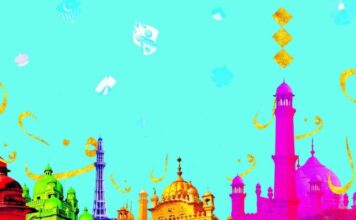By Bhaswati Bhattacharya
Diwali, the sloppy, shortened form of deep-awali (deep = oil lamp, awali = in a row) is the darkest of nights turned into a willful force of light. A billion people light oil lamps on the no-moon night in the ancient month of Karthik, which now corresponds to November.
Over the millennia, this night has had many significant manifestations. One was the night Rama came back after the war against a dark wiseman who rotted over time to become a demonic black lord. According to astronomy-based historian Nilesh Nilkanth Oak, it occurred in the year 12209 BCE. Rama and Ravana waged a war in Sri Lanka, and Rama returned victorious with his family and soldiers walking most of the length of the subcontinent back to Ayodhya and arriving on the night of the new moon. To guide his way back home, the people lit oil lamps, in welcome and joyous victory of good over evil.
Today, that story is seldom retold to keep it alive. People now light firecrackers, creating environmental pollution, and dangerous street conditions for days around Diwali. The new moon is not even understood by many westernized Indians. Diwali is now about boasting wealth, bling, and power with ostentatious displays of fireworks and belly-stuffing parties.
In Bengal, the story of Rama is too recent. Akhanda Bengal (the land of Bengal before the British partitioned it in 1905) goes back to the legends of Kali, the reputed dark goddess who warred against evil and went mad. To bring her to her senses, her husband Shiva lies down in her path and when she steps on him, she reawakens.
The common images of Kali epitomize the transformative power we hold inside us when we awaken and are taken aback to greater truths hidden during our mental darkness. The symbolism of our mental madness that brings ignorance, destruction, poverty and stupidity in action and bluntness in thinking dominates us until we are restored. Kali is time and rules over the material world that Shiva created. She is eternal and he is at her mercy, though he also dances with her in creating all he desires.
She reminds us that our natural state is clarity, brought back to us with the light of universal wisdom, which also restores the balance of wealth and intelligence. From the late night rituals to Kali on the darkest night with no moon, we rise into a clean dawn that brings the opportunity of a new chance.
The symbolism is lost on most of society, as the nitwits ritualize demons and gods at opposite ends and invite forms of blind worship, animal sacrifice and various rituals. These were witnessed by European invaders who called themselves scholars. Shocked at what they saw, which further encouraged some of the low-minded native worshippers to engage them more, the reports of Kali and black magic permeated the scholarly texts of the ignorant watchers who were fascinated, disgusted but entrapped. Their teachings then fueled the significant numbers of English educated Indians who worshipped modern English thought. Over the past century, Kali has been separated from the teachings of her symbolism. She whispers to us to learn the secrets of Time.
Kali means black, dark, and destructive, but it is also derived from the term kaala which means the illusion of time and change. Kali reminds us of the life-death-life cycle all around us. We all secretly know that the death of certain humans has saved our lives. In a forest, when a life dies by falling off its tree, new life is born in the ants that eat it on the ground. The animal food chain in Nature also typifies life-death-life. In humans, our life experiences are remembered through our linear layout of time.
Ayurveda whispers to us that every ritual of Kali Puja is a reminder of what can heal our darkness. Meat provides the strength that ayurvedic texts prescribes to the convalescent. Lighting oil lamps takes the extra oils trapped inside us and burns them to produce the warmth and light we need inside of us. The feminine power of starting a family and creating a safe home is remembered. The domestic home, as the start of a powerful person, fed in his gut, mind and heart with the goodness of a well-kept place, is the focal place of the Puja. The home is cleaned, just as the body should be. The home is decorated, just as the body should be.
Kali-Maa is the all-pervading power because she is the embodiment of mother time.
Western mythology and symbolism include the Greek god Cronos who ruled over agriculture. Cronos was a Titan and ruled with his harvester’s sickle over the cycles of seasons and time, which brought either health and wealth or a bad crop, which yielded death and destruction. From the name Cronos, we have chronology, the study of time.
In the Dark Ages of Europeans, when they could not figure out the cause of their pandemics of plague, the grim reaper stole the sickle from Cronos and became the old man Death with wings and an hourglass. Sometimes he held a snake with its tail in its mouth as the circle of eternity to remind people of the ever passing of time. In Europe, the white Old Father Time hands over the end of year to Baby New Year, with symbols of fresh new innocence. His other son is Truth, whose power is to dispel falsehoods, envy and frauds. Father Time is married to Mother Earth.
Kali is black because Time absorbs all light, all colors, all sound. It takes no excuses and makes exceptions for no-one. It is one of the few perfect things in the Universe and is one, vibhu (omnipresent) and eternal. Kali-Maa is worshipped because of this fierceness. She forces us to succumb to her if we want to live in the material world.
However, time is also abundantly merciful, forgetting mistakes of the past and allowing people to move forward. Time heals wounds. Time heals failures with new opportunities. Time allows us to try again, learn new skills, and make new attempts. She also teaches those who are deeper seekers how to escape time and use the tool to heal, to repair, and to bring light into any darkness.
On the dark night of Diwali, people pray to the forces of the universe to carry them into the light, to take the part of them that lies in ignorance, hate and “not-enough”-ness into the place of living in the present. Lighting an oil lamp is the ritual that helps us transform any dark space in ourselves into light. The potential for forgiveness, fullness with love, light, and abundance is lit.










